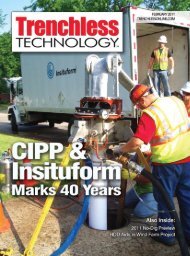Author: Professor, Dr. Dietrich Stein - TrenchlessOnline
Author: Professor, Dr. Dietrich Stein - TrenchlessOnline
Author: Professor, Dr. Dietrich Stein - TrenchlessOnline
You also want an ePaper? Increase the reach of your titles
YUMPU automatically turns print PDFs into web optimized ePapers that Google loves.
INTERNATIONAL<br />
Grouted-in-Place Pipe<br />
Method Used to Reline<br />
German Sewer Lines<br />
By Jens Kirste<br />
Nowadays sewer network owners and operators<br />
are faced with a huge number of different trenchless<br />
methods, materials and suppliers to seal and<br />
rehabilitate their pipes.This applies especially for<br />
cross-sectional pipe dimensions up to approximately 1,000<br />
mm inside diameter (I.D.). Above that size, the number of<br />
approved systems and qualified installers reduces to a comparably<br />
small amount.<br />
Since the early 1990s, Trolining GmbH, Troisdorf,<br />
Germany, has been an internationally recognized expert in<br />
the field of trenchless pipe rehabilitation.Its patented grouted-in-place<br />
pipe (GIPP) method has been successfully<br />
installed in about 20 countries around the globe.The continuously<br />
growing demand for reliable methods for the reinstatement<br />
of large sewers was a clear sign for Trolining to<br />
further increase the effectiveness of its system in that market<br />
segment. Pipe sizes between 800- and 2,000-mm I.D.<br />
today represent Trolining’s main field of application, regardless<br />
of whether the cross-sectional pipe profile to be<br />
rehabbed is circular or a special geometry.<br />
Studded HDPE liner inside the host pipe, just before inflation to adapt to<br />
the host pipe’s egg-shape, sized 1,400 x 2,100 mm.<br />
In the second half of 2006,Trolining completed a project in<br />
the City of Bielefeld, Germany. Bielefeld is a medium-size<br />
town with about 330,000 inhabitants and an urban area of<br />
258 sq km.The total length of public sewers herein is approximately<br />
1,840 km. Regular inspections revealed leaking and a<br />
variety of other damages at one of the main collectors located<br />
along the Mühlen Str., near the city center. Most notably,<br />
the joints of the brick sewer, constructed around 1898, were<br />
found severely eroded.In some areas,the mortar between the<br />
bricks was missing down to a depth of 40 mm.<br />
After assessment of the inspection reports, the municipality<br />
decided that 520 m of the sewer needed urgent repair.<br />
Whereas 310 m showed the standard egg-shape 1,200- x<br />
1,800-mm I.D., further 210 m measured 1,400 x 2,100 mm.<br />
A few months later, Bielefeld’s environmental authority<br />
released a call for tender not only containing the trenchless<br />
rehabilitation of the mentioned sewer lines, but also a number<br />
of other preparatory and adjacent works. Installation of<br />
a bypass line, preliminary sealing of major groundwater infiltration,rehabilitation<br />
of the adjacent manhole chambers and<br />
re-connection of the lateral pipes were just some of the performances<br />
requested from the bidders.<br />
The Trolining System<br />
The Trolining trenchless pipe rehabilitation system is<br />
based on various high-density polyethylene (HDPE) liner<br />
components, which can be combined in a wide range of<br />
alternative configurations. The heart of the system is the<br />
Troliner with its V-shaped embedment studs. The annular<br />
void created by the studs is filled with Trolining Injektor, a<br />
specially engineered injection grout. This high-strength<br />
grout fixes the Troliner liner permanently in place and provides<br />
the load-bearing shell of the system.<br />
Trolining liners are available for pipes ranging from 250to<br />
2,000-mm I.D. Segmental lining sheets are offered for<br />
rehabilitation of lines greater than 2,000-mm I.D. and for<br />
elbows and corners in man-size lines. The rehab system<br />
improves the host pipe’s flow characteristics and provides<br />
exceeding mechanical and chemical resistance.<br />
Every liner is tailor-made according to the exact measurements<br />
taken on the jobsite.That procedure guarantees the<br />
systems “close-fit” characteristics, thus limiting the cross-sectional<br />
reduction to an absolute minimum. Prior to the liner<br />
insertion, the pipe section to be rehabilitated is plugged-off<br />
at both ends, cleaned and visually inspected.A cable winch<br />
is then used to unroll each HDPE liner from its transport<br />
drum and draw it through the line into position.After insertion,<br />
all HDPE liners are welded together at their ends.The<br />
resulting liner — a sandwich — is then inflated with a defined<br />
pressure through passages in the temporary plugs closing<br />
the ends of the liner section.<br />
When the required inflation pressure is attained, the<br />
annular void is filled with Trolining injection grout fed from<br />
the downstream end. The grout’s extremely low viscosity<br />
48 TRENCHLESS TECHNOLOGY September 2007 www.trenchlessonline.com








